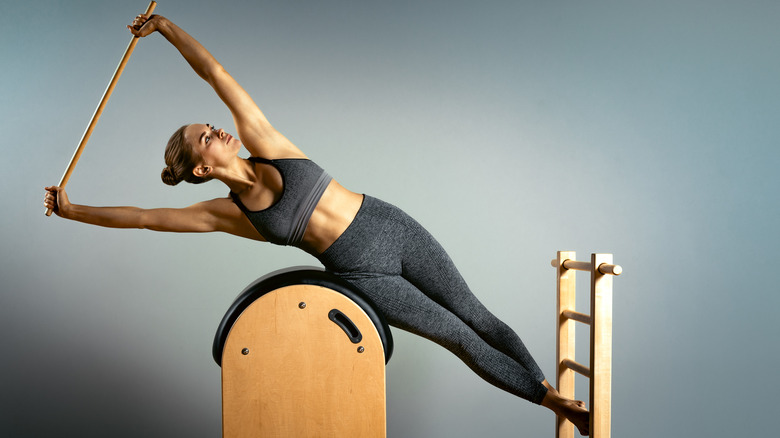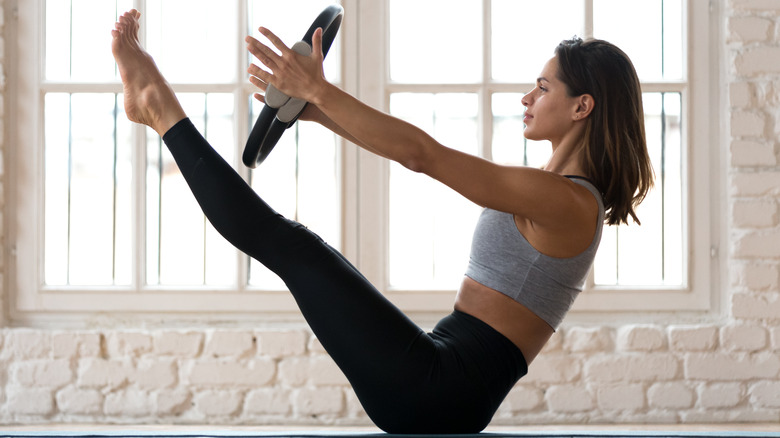Is Pilates Really The Ultimate Workout It's Cracked Up To Be?
The praises of Pilates have been sung far and wide. No matter how much you avoid it, you'll hear about the workout's greatness from everyone from TikTok influencers to Victoria's Secret models to your fittest friends. Nobody can seem to get enough of these supposedly life-changing exercises. It might be surprising to learn that this modern-day trend actually began all the way back in the 1920s under the name of "Contrology." Although it's a form of full-body exercise now, in its original form, Pilates was primarily used for rehabilitation by its eponymous creator, Joseph Pilates.
These days, the word Pilates gets thrown around pretty loosely. Fluidform Pilates' director Kirsten King explained what it actually means during a chat with Elle Australia: "It is an exercise system that works on the stabilizing muscles to ensure the most optimal posture." She added, "There is a keen focus on [the] core (internal stomach muscles and obliques) as well as lengthening the muscles throughout the body. It is performed with and without equipment."
When you see people doing Pilates, things can get even more confusing because they don't seem to be doing much to justify all the hype, but when you try it out for yourself, you realize just how hard these seemingly simple movements really are. So, if you're in two minds about whether or not you should sign up for a Pilates class, there are a few pros and cons that you can weigh up to make the decision easier.
Pilates benefits more than just your core
Unsurprisingly, Pilates has gained a reputation as the workout of choice for dancers because of the improvements it can bring to one's form. If you've seen a Pilates video, you'll notice several limb movements you've probably never attempted. There's a reason for that. Pilates aims to give you better flexibility by lengthening your muscles in a full range of motion and stretching them out to reduce the tightness you might experience from sitting through most of your workday, for instance.
Balance is one of the foundational pillars of Pilates. When you align your body to accomplish a Pilates move or move your limbs in opposing directions, you use your core strength to stay balanced. If you're someone who deals with end-of-the-day neck and lower back pain from slouching over your laptop, Pilates can help. As Rebecca Lubart, founder of Dynamic Body Pilates, informed Well+Good, "You build awareness of how to find postural support with your muscles, not just to reverse slouching."
Further, "An increased understanding and awareness of how you hold your body plays a big role in this as well." Pilates can also help you have better workouts more generally by enabling you to form better mind-muscle connections and strengthening your core to take unnecessary pressure off the injury-prone back. It can also help relieve stress due to the deep focus on breathing and stretching. Since it's a relatively low-impact exercise regime, Pilates can also help you get back into fitness post-injury.
Pilates isn't a one-size-fits-all workout
There's no denying that Pilates can be hugely beneficial, but it's not necessarily the be-all-end-all workout it's frequently made out to be. A Pilates workout's effectiveness depends predominantly on your goals. If you're looking to gain muscle mass, for instance, then Pilates can't help you do that as effectively as strength training. It can help with toning the muscles you already have, though.
For those looking to gain cardiovascular strength, Pilates isn't quite as effective as either walking or jogging outside or using a machine at the gym. Sure, a good Pilates workout will get your heart rate going, but it's not considered a cardio replacement because the primary goal is to improve muscle strength. Since Pilates mainly works to improve balance, flexibility, and strength, you also may not see any visible progress for a while.
Pilates has a deep emphasis on feeling your body move and paying attention to your limitations to find areas for improvement. To do this, you have to focus a great deal, and if you're someone who finds their mind wandering off during workouts, then it might take you longer to really feel challenged. Generally, a Pilates class costs a pretty penny too, so it's not a feasible option for those on a budget. Overall, if you have a free trial at your local gym or Pilates center, then seize the opportunity to see how it makes you feel.


